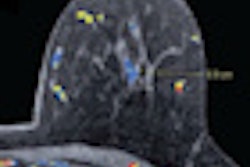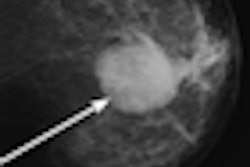Nearly 65,000 more women would lose their lives from breast cancer if the U.S. Preventive Services Task Force's (USPSTF) controversial 2009 guidelines on screening mammography were adopted on a widespread basis, according to a study in the February issue of the American Journal of Roentgenology.
The new study claims that the USPSTF ignored scientific data available to it when it issued guidelines in November 2009 recommending that screening mammography be limited to women 50 to 74 years old, rather than include women ages 40 to 49, as was the case under the task force's previous guidance.
The USPSTF also overemphasized the potential harms of screening mammography, and the panel has dealt a serious blow to efforts to improve mammography screening rates, according to lead author Edward Hendrick, PhD, of the University of Colorado at Denver, and colleague Mark Helvie, MD, at the University of Michigan Health System in Ann Arbor (AJR, February 2011, Vol. 196:2, pp. W112-W116).
"The USPSTF recommendations have done potential damage to women's health by failing to seize the singular opportunity to both improve mammography in the United States and to increase screening mammography compliance," the authors wrote. "Their recommendations have dissuaded some women from undergoing mammography."
Dissecting the data
In the new study, Hendrick and Helvie analyzed much of the data that the USPSTF used to develop its recommendations, which, in addition to raising the screening age, also advised biennial rather than annual screening.
Hendrick and Helvie noted that for the policy revision, the USPSTF considered the following:
- Randomized, controlled trial data on screening mammography, as analyzed and summarized in a report by the Oregon Evidence-Based Practice Center at Oregon Health and Science University.
- "Harms" associated with screening mammography, as summarized in the report above. Harms included radiation exposure, pain during procedures, patient anxiety, consequences of false-positive and false-negative test results, and overdiagnosis of breast cancer.
- Age-specific screening results from the Breast Cancer Surveillance Consortium.
- Modeling of 20 different screening mammography regimens, starting and ending at various ages and including annual and biennial screening. The modeling was conducted by six groups under the Cancer Intervention and Surveillance Modeling Network project, funded by the U.S. National Cancer Institute.
However, the USPSTF did not consider peer-reviewed studies (that were not randomized, controlled trials) that assessed the value of screening mammography using mortality as the outcome measure. The task force also did not consider peer-reviewed analyses of the cost-benefit of screening mammography compared with other interventions.
"We looked in detail at the data the USPSTF considered," Hendrick said. "But it took some time, not only because there's a lot of data, but also because the USPSTF didn't announce its data sources until the recommendation had already been released."
Hendrick and Helvie used the six Cancer Intervention and Surveillance Modeling Network models of screening mammography to compare the mortality reduction for a hypothetical cohort of women just coming of screening age who followed the USPSTF's 2009 recommendation for mammography screening. They then compared this group to a hypothetical cohort that followed the American Cancer Society's recommendation of annual screening beginning at age 40.
For the 20 million U.S. women currently 30 to 39 years old, annual screening mammography from ages 40 to 84 years would save almost 65,000 more lives than if these women followed USPSTF recommendations, Hendrick and Helvie calculated, assuming the current 65% mammography compliance rate. At a 100% screening compliance rate, the numbers of lives saved would rise to 100,000 individuals, the authors wrote.
Averaged over the six models of benefit, screening mammography showed the greatest benefit for annual screening in women 40 to 84 years old, with a 39.6% mortality reduction, Hendrick and Helvie found, a screening protocol that saves 71% more lives than the USPSTF-recommended 2009 regimen (which has a 23.2% mortality reduction).
The authors also estimated the harms for mammography screening using the Breast Cancer Surveillance Consortium data, evaluating the number of years a woman would need to undergo annual screening to encounter one of the "harms" mentioned by the USPSTF.
They found that the potential harm of a screening examination in women 40 to 49 years of age consists of the risk of a recall for diagnostic workup every 12 years, a negative biopsy every 149 years, a missed breast cancer every 1,000 years, and a fatal radiation-induced breast cancer every 76,000 to 97,000 years, the authors wrote.
Finally, Hendrick and Helvie believe that the USPSTF erred in developing its estimate of the value and harms of screening mammography. In releasing its 2009 recommendation, the task force stated that 1,904 women would need to be invited to screening in order to save one life in the 40- to 49-year-old cohort.
However, Hendrick and Helvie noted that the "number needed to invite" is frequently misinterpreted as "number needed to screen," and that the former is at least 25% to 30% greater than the latter due to nonattendance rates. The potential harms cited by the USPSTF apply only to women who actually attend screening mammography, not to those who are merely invited.
"When you look at the data the USPSTF considered [for this recommendation], it supports a strong argument for annual screening beginning at age 40," Hendrick told AuntMinnie.com. "I think the USPSTF members were acting in good faith, but it's frankly appalling that they could look at that data and come to the conclusions they did. The goal is to save lives, not to perform the least amount of mammograms possible."
By Kate Madden Yee
AuntMinnie.com staff writer
January 25, 2011
Related Reading
The breast screening hullabaloo: Where are we today? August 19, 2010
Senator asks HHS to strike USPSTF guidelines, May 12, 2010
House bill would bar use of USPSTF guidelines to deny coverage, March 11, 2010
Avon: USPSTF guidelines already affecting access, February 22, 2010
USPSTF guidelines influencing doctors, poll finds, February 16, 2010
Copyright © 2011 AuntMinnie.com




















